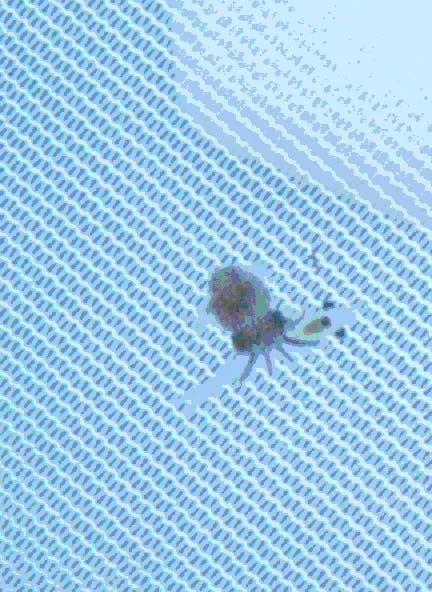
 |
| Home | What's New? | Cephalopod Species | Cephalopod Articles | Lessons | Bookstore | Resources | About TCP | FAQs |
Euprymna tasmanica, Southern Dumpling squid<< Cephalopod Species | By David SinnEuprymna tasmanica, or the southern dumpling squid, is a relatively unstudied benthic squid found in shallow waters (0.5 m to at least 75 m deep) along the continental shelf in the temperate waters surrounding southern Australia (M. Norman & Reid, 2000).  Mature adults are commonly found in Tasmania in the 20-30 mm mantle length size range. The sexes are dimorphic; males can be distinguished by the hectocotylzed first left arm. Males also have an interesting arrangement of enlarged suckers that can be displayed in an "arm flower posture" [Figure 1]. Although the purpose of this display is unknown, individuals from both sexes and all sizes will perform this posture with varying frequency and magnitude across a number of different situations. Depending on season of birth, the life span of this species is anywhere from 5 to 8 months. Females lay 2-3 batches of eggs over a period of weeks towards the end of their life span, usually 25-170 eggs/batch. Females mate with multiple partners prior to laying eggs and research has begun in other species to examine the how some female squid may use sperm from multiple partners in a single egg batch (Hanlon, Maxwell, & Shashar, 1997). Newly-hatched young are morphologically well advanced, and can catch prey items up to twice their size [Figure 2]. There is no generational overlap, and hatchlings have to survive from birth without parental care. Females die approximately 8-14 days after laying eggs; males will also die after mating, but do perform multiple matings with multiple females before death. Sepiolid squid are generally nocturnal and cryptic (Singley, 1983), and are unique among the cephalopods in that they use a mucus-lined sand coat as camouflage during daylight hours or while being threatened (M. Norman & Reid, 2000). While Euprymna are of interest for biomedical purposes due to their symbiotic light organ associations (Lee & Ruby, 1994; Ruby & Lee, 1998) and for ethologists due to their behaviour (Moynihan, 1982; Sinn & Moltschaniwskyj, in submission), almost nothing is known concerning the biology or behaviour of this sepiolid. Its behavior, like that of other cephalopods, is complex. This provides ethologists and marine biologists an exciting opportunity to study the behavior of an advanced invertebrate.  Figure 1 – Euprymna tasmanica "arm flower posture". Note the enlarged suckers near the proximal ends of the arms. Also note the hectocotylzed first left arm (the one on the right in the "V"). Photo by Rebecca van Gelderen  Figure 2 – A hatchling Euprymna holding a mysid shrimp approximately twice its size. Cephalopods need live food in the lab; this photo was taken after a young squid actively hunted and captured its swimming prey. Photo by Tom Fox-Smith  Figure 3 - Wild Euprymna tasmanica sitting on sand/mud-flat at Kelso, Tasmania. Photo courtesy of John Forsythe ReferencesHanlon, R. T., Maxwell, M. R., & Shashar, N. (1997). Behavioral dynamics that would lead to multiple paternity within egg capsules of the squid Loligo pealei. Biological Bulletin, 193, 212-214.Lee, K. H., & Ruby, E. G. (1994). Effect of the squid host on the abundance and distribution of symbiotic Vibrio fischeri in nature. Applied and Environmental Microbiology, 60, 1565-1571. Moynihan, M. (1982). Notes on the behavior of Euprymna scolopes (Cephalopoda: Sepiolidae). Behaviour, 85, 25-41. Norman, M., & Reid, A. (2000). A Guide to Squid, Cuttlefish, and Octopuses of Australasia. Collingwood, Victoria: The Gould League and CSIRO Publishing. Norman, M. D., & Lu, C. C. (1997). Redescription of the southern dumpling squid Euprymna tasmanica and a revision of the genus Euprymna (Cephalopoda: Sepiolidae). Journal of the Marine Biological Association of the United Kingdom, 77, 1109-1137. Ruby, E. G., & Lee, K. H. (1998). The Vibrio fischeri-Euprymna scolopes light organ association: Current ecological paradigms. Applied and Environmental Microbiology, 64, 805-812. Singley, C. T. (1983). Euprymna scolopes, Cephalopod Life Cycles (Vol. 1, pp. 69-74). London: Academic Press. Sinn, D. L., && Moltschaniwskyj, N. A. (in submission). Personality traits in the Southern dumpling squid (Euprymna tasmanica): context-specific differences and potential biological correlates.
| ||||||
| Home | What's New? | Cephalopod Species | Cephalopod Articles | Lessons | Resources | About TCP | FAQs | Site Map | |
 |
The Cephalopod Page (TCP), © Copyright 1995-2024, was created and is maintained by Dr. James B. Wood, Associate Director of the Waikiki Aquarium which is part of the University of Hawaii. Please see the FAQs page for cephalopod questions, Marine Invertebrates of Bermuda for information on other invertebrates, and MarineBio.org and the Census of Marine Life for general information on marine biology. |